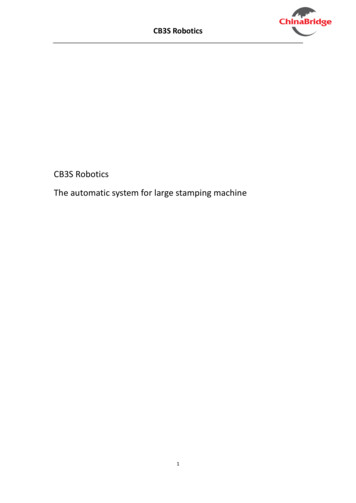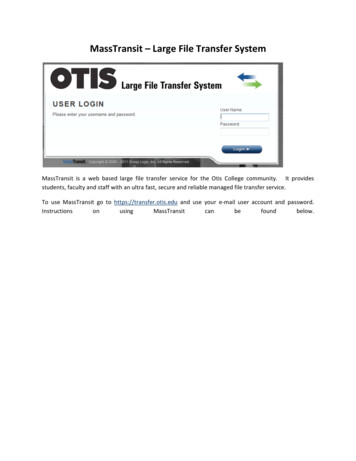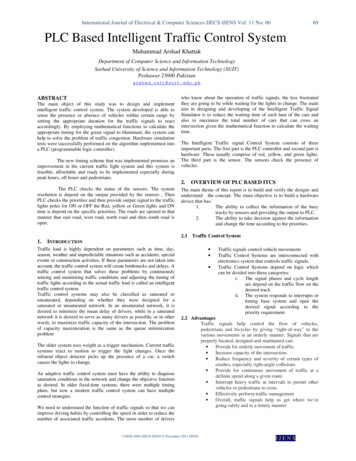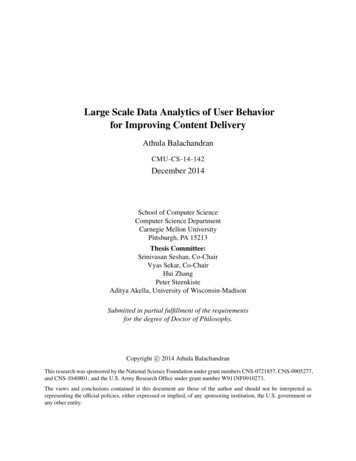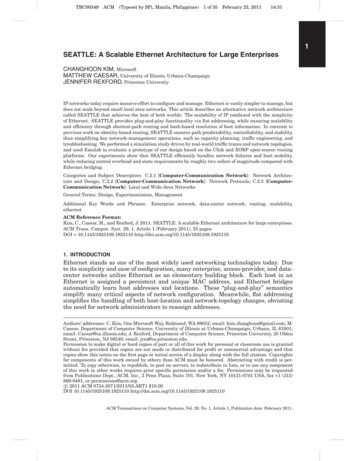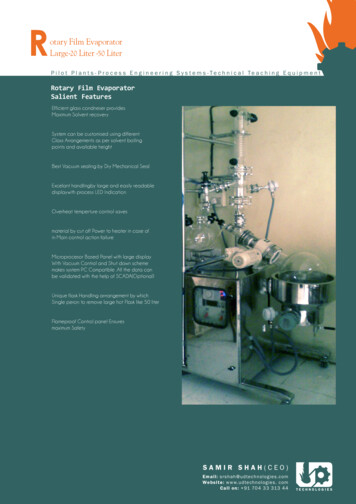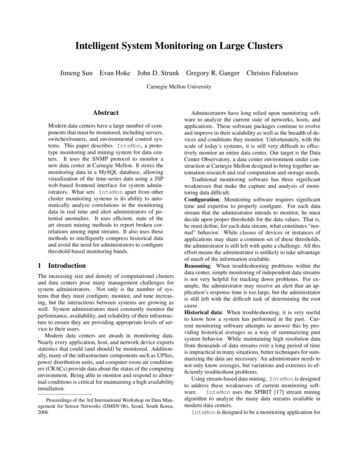
Transcription
Intelligent System Monitoring on Large ClustersJimeng SunEvan HokeJohn D. StrunkGregory R. GangerChristos FaloutsosCarnegie Mellon UniversityAbstractModern data centers have a large number of components that must be monitored, including servers,switches/routers, and environmental control systems. This paper describes InteMon, a prototype monitoring and mining system for data centers. It uses the SNMP protocol to monitor anew data center at Carnegie Mellon. It stores themonitoring data in a MySQL database, allowingvisualization of the time-series data using a JSPweb-based frontend interface for system administrators. What sets InteMon apart from othercluster monitoring systems is its ability to automatically analyze correlations in the monitoringdata in real time and alert administrators of potential anomalies. It uses efficient, state of theart stream mining methods to report broken correlations among input streams. It also uses thesemethods to intelligently compress historical dataand avoid the need for administrators to configurethreshold-based monitoring bands.1IntroductionThe increasing size and density of computational clustersand data centers pose many management challenges forsystem administrators. Not only is the number of systems that they must configure, monitor, and tune increasing, but the interactions between systems are growing aswell. System administrators must constantly monitor theperformance, availability, and reliability of their infrastructure to ensure they are providing appropriate levels of service to their users.Modern data centers are awash in monitoring data.Nearly every application, host, and network device exportsstatistics that could (and should) be monitored. Additionally, many of the infrastructure components such as UPSes,power distribution units, and computer room air conditioners (CRACs) provide data about the status of the computingenvironment. Being able to monitor and respond to abnormal conditions is critical for maintaining a high availabilityinstallation.Proceedings of the 3rd International Workshop on Data Management for Sensor Networks (DMSN’06), Seoul, South Korea,2006Administrators have long relied upon monitoring software to analyze the current state of networks, hosts, andapplications. These software packages continue to evolveand improve in their scalability as well as the breadth of devices and conditions they monitor. Unfortunately, with thescale of today’s systems, it is still very difficult to effectively monitor an entire data center. Our target is the DataCenter Observatory, a data center environment under construction at Carnegie Mellon designed to bring together automation research and real computation and storage needs.Traditional monitoring software has three significantweaknesses that make the capture and analysis of monitoring data difficult.Configuration: Monitoring software requires significanttime and expertise to properly configure. For each datastream that the administrator intends to monitor, he mustdecide upon proper thresholds for the data values. That is,he must define, for each data stream, what constitutes “normal” behavior. While classes of devices or instances ofapplications may share a common set of these thresholds,the administrator is still left with quite a challenge. All thiseffort means the administrator is unlikely to take advantageof much of the information available.Reasoning: When troubleshooting problems within thedata center, simple monitoring of independent data streamsis not very helpful for tracking down problems. For example, the administrator may receive an alert that an application’s response time is too large, but the administratoris still left with the difficult task of determining the rootcause.Historical data: When troubleshooting, it is very usefulto know how a system has performed in the past. Current monitoring software attempts to answer this by providing historical averages as a way of summarizing pastsystem behavior. While maintaining high resolution datafrom thousands of data streams over a long period of timeis impractical in many situations, better techniques for summarizing the data are necessary. An administrator needs tonot only know averages, but variations and extremes to efficiently troubleshoot problems.Using stream-based data mining, InteMon is designedto address these weaknesses of current monitoring software.InteMon uses the SPIRIT [17] stream miningalgorithm to analyze the many data streams available inmodern data centers.InteMon is designed to be a monitoring application for
large-scale clusters and data centers. It will complementexisting solutions by providing automatic mining as wellas efficient storage for the many data streams common intoday’s clusters. In particular, it can observe the correlations across data streams, summarizing them in a succinctmanner; it can pick up anomalous behaviors that manifestas broken correlations; it can summarize historical data ascompact “hidden variables” that can be used to approximately reconstruct the historical data when needed.InteMon seeks to decrease the burden of system monitoring in several ways. First, it decreases the level of expertise necessary to configure the monitoring system. Itaccomplishes this by removing the need for the administrator to set “alert” thresholds for the incoming data. Throughstream mining techniques, it learns correlations in the datastream and can flag deviations.Second, instead of just examining each data stream inisolation, InteMon looks for correlations across datastreams. An alert is generated when the SPIRIT algorithm detects a change in the level of correlation acrossdata streams. The existence (or disappearance) of thesecorrelations provides the system administrator with a starting point for troubleshooting activities.Third, by performing a variant of incremental principalcomponent analysis, SPIRIT [17] is able to incrementallyand compactly express the correlations and variations ofthe data across streams as well as detect abnormal behavior.This allows historical data to be intelligently summarized,preserving cross-stream correlation and flagging regions ofinterest that should be preserved in high detail for futurereference. The techniques and benefits of InteMon arecomplementary to those provided by existing monitoringinfrastructures, improving the types of (mis-)behaviors thatcan be flagged and improving the detail with which historical data is preserved.Our prototype system allows these techniques to be evaluated in a real environment. It provides a web-based interface to allow a system administrator to view anomaliesdetected in the monitored data streams. It is currently monitoring a subset of the infrastructure in Carnegie Mellon’sData Center Observatory.The rest of the paper is organized as follows: Section 2gives a brief literature survey; Section 3 discusses the keyideas behind InteMon; Section 4 presents the architecture of our system; Section 5 illustrates the stream miningalgorithm; Section 6 discusses some early experiences withthe system as well as future work; Section 7 concludes.2Related workThere are a number of research and commercial monitoring systems, mainly focusing on system architecture issues such as scalability and reliability. Ganglia [18] isa hierarchical monitoring system that uses a multicastbased listen/announce protocol to monitor nodes withinclusters, and it uses a tree structure to aggregate the information of multiple clusters. SuperMon [19] is anotherhierarchical monitoring system which uses a custom ker-nel module running on each cluster node. ParMon [5] isa client/server monitoring system similar to ours but without mining capabilities. There exist commercial monitoring suites, such as OpenView [13], Tivoli [14], and BigBrother [4], as well as several open-source alternatives, including Nagios [16]. These systems are primarily drivenby threshold-based checks. As long as the result of a querylies within a predefined range, the service is considered tobe operating normally.There is a lot of work on querying stream data, whichincludes Aurora [1], Stream [15], Telegraph [8] and Gigascope [9]. The common hypothesis is that (i) massive datastreams come into the system at a very fast rate, and (ii)near real-time monitoring and analysis of incoming datastreams is required. The new challenges have made researchers re-think many parts of traditional DBMS designin the streaming context, especially on query processing using correlated attributes [11], scheduling [3, 6], load shedding [10, 20] and memory requirements [2].Here, we focus on the SPIRIT algorithm [17], whichperforms PCA in a streaming fashion, discovering the hidden variables among the given n input streams and automatically determining when more or fewer hidden variables are needed.3Main IdeaIn this section, we present the main idea behind InteMon.In a nutshell, it tries to spot correlations and redundancies.For example, if the load on disk1, disk2, . . . disk5 moves inunison (perhaps they are part of the same RAID volume),we want InteMon to spot this correlation, report it thefirst time it happens, and report it again when this correlation breaks (e.g., because disk2 starts malfunctioning).The key insight is the concept of hidden variables: whenall five units work in sync, they report five loads, but inreality all five numbers are repetitions of the same value,which we refer to as a “hidden variable.” Correlations canalso be more complicated (e.g., for a specific application,the disk load is a fraction of the CPU load). There can evenbe anti-correlations.This viewpoint simplifies all three problems we mentioned in the introduction. Tracking a few, well chosen hidden variables allows for automatic configuration, anomalydetection, and compression:Configuration: the human user does not need to know thenormal behavior of a data stream: InteMon will learn iton the fly, and it will complain if there are deviations fromit.Reasoning: InteMon will report the timestamp and thenumerical weights of the input data streams that caused thechange in correlation. This provides the administrator withan ordered list of data streams that were involved in theanomaly, allowing him to focus on the most likely culprit.Historical data: We can save a significant amount of spacewhen storing historical data. First, there are fewer hiddenvariables than raw data streams, but there is still enough information to approximately reconstruct the history, because
hrSystemProcesses.0hrStorageUsed.1DescriptionBytes ReceivedUnicast Packets ReceivedBytes SentUnicast Packets SentUnprivileged CPU UtilizationPrivileged CPU UtilizationOther CPU UtilizationCPU Idle TimeAvailable MemoryNumber of UsersNumber of ProcessesDisk UsageTableMACHINESIGNAL TYPESTREAMSPIRIT INSTANCENORMALIZE FUNCTIONINSTANCE MEMBERRAW DATAHIDDENRECONSTRUCTALERTALERT WEIGHTFieldsid, type, name, addressid, properties, name, oidid, machine, signal typeid, name, normalize functionid, name, functionstream id, spirit idstream id, time, valuehidden id, spirit id, time, valuestream id, spirit id, time, valuespirit id, time, alert id, propertiesalert id, stream id, weightTable 2: Database tables used by InteMonTable 1: Example SNMP metrics used by InteMonthere are redundancies and correlations. Second, since weknow which timestamps were anomalous, we can storethem with full information, compressing the rest of normal,“boring” data. This is analogous to compression for videosurveillance cameras: during the vast majority of the time,things are normal, successive frames are near-identical, andthus they can be easily and safely compressed; we onlyneed to store the snapshots of a few “normal” timestamps,as well as the snapshots of all the “anomalous” ones.Next, we present the details of our implementation: thesoftware architecture of our system and the user interface.In Section 5, we also present the mathematical technique toachieve on-line, continuous monitoring of the hidden variables.4System ArchitectureIn this section, we present our system design in detail. Section 4.1 introduces the real-time data collection process formonitoring sensor metrics in a production data center. Section 4.2 presents the database schemas for data storage.Then Section 4.3 shows the functionalities of the web interface.4.1 Monitoring sensor metricsMonitoring is done via the Simple Network ManagementProtocol (SNMP) [7]. SNMP was chosen because it is awidely used protocol for managing devices remotely, suchas routers, hosts, room temperature sensors, etc. The largenumber of devices that support SNMP made it a naturalplace to start for data collection. However, any protocolthat allows time-series data to be obtained could be usedwith InteMon.Data collection is done through a daemon process running on a designated server. This server is configured toquery a designated set of sensor metrics (see Table 1) fromall hosts in the data center using SNMP. At specific intervals, typically a minute, the server will query, via thesnmpget program, each of the hosts and store the resultin a customized MySQL database. Individual queries arespread out uniformly in the entire period to reduce the concurrent server load, and the load on clients is negligible.The streaming algorithms are then run across the incomingdata to detect any abnormalities.4.2Database backendIn order to facilitate easily grabbing data via SNMP, theMACHINE table contains the host names of all the machines to be monitored, and the SIGNAL TYPE table contains the OIDs of all the signals to be monitored. Whenthe daemon runs, it performs a lookup in the STREAMtable for all the streams that belong to each machineand queries the current value of each OID, via SNMP.The returned values are then stored in the RAW DATAtable, keyed by their stream id and time. Because theSTREAM table maps OIDs to machines, we have complete flexibility over which signals are monitored on eachmachine. SPIRIT INSTANCE allows complete flexibilityover which signals are grouped together for analysis. Anentry in this table exists for each distinct set of streamsthat are analyzed together with a given normalization function that points to entries in a NORMALIZE FUNCTIONtable. A NORMALIZE FUNCTION entry is a functionapplied to the data before it is analyzed for correlations.There is also an INSTANCE MEMBER table that mapseach signal to the SPIRIT INSTANCEs to which they belong. For example, to analyze correlations in network activity, a SPIRIT INSTANCE could be created with all thenetwork activity streams as members.The data is then analyzed for correlations and the resulting hidden variables found are stored in the HIDDENtable, keyed by the SPIRIT INSTANCE to which they belong, as well as the time. A change in the number of hidden variables indicates something anomalous is happening,causing the current correlations to break down. This triggers an alert which is stored into the ALERT table. Thealert id keys into the ALERT WEIGHT table, which contains the relative weights of the signals that contribute to thenew hidden variable. This provides an indication of whatcaused the correlation to break down, and it is useful fordiagnosing the source of the problem. As a sanity check ofthe hidden variables, the original data is reconstructed fromthe hidden variables and stored in the RECONSTRUCT table.
4.3Web interfaceThe JSP-based web interface is currently running onApache Tomcat 5.5.15 with JRE 1.5.0. It consists of a mainpage with links to monitoring pages for each type of signaland each host. Also, this page lists the most recent alertsand the hosts/signals they affect as well as a link to a moreextensive page of abnormalities. This provides the systemadministrator with the pertinent information that needs tobe addressed immediately as well as tools to investigatefurther.The individual monitoring pages consist of three graphs,shown in Figure 1. These graphs are generated with theJFreeChart library version 1.0.1. Current graphs are cachedfor improved performance, while graphs of older data aregenerated on the fly. For the signal monitoring pages, thefirst graph contains a minute-by-minute plot of all the signals of a given type, across hosts.The second graph contains the hidden variables. For example, if all machines show the same pattern of CPU utilization, (e.g., a daily cycle), we have only one hidden variable, which is exactly a sinusoid-like wave with 24 hour period; now if half of the machines get overloaded to a 90%utilization, we need a second hidden variable, constant at90%, to capture the fact. The system not only flags theabnormal timestamp, but also identifies the cause from association weights to the new hidden variable. In this case,CPU utilization has the largest association weight to thesecond hidden variable.The last graph gives the reconstructed data. This graphuses only the hidden variables to try to approximate theoriginal data, giving the user a feel for how well the algorithm is working. The host monitoring pages are similar,except they provide graphs of all signals monitored on aspecific host. On each graph, vertical bars are drawn atthe locations where abnormalities occur (i.e., the numberof hidden variables changes). These pages provide navigation to other monitoring pages via pull down menus as wellas links to move forward and backward in time.5Stream miningIn this section, we describe the underlying mining algorithm in more detail. We follow standard matrix algebranotation for the symbols: Bold capital letters are matrices(e.g., U); the transpose of a matrix is denoted with a Tsuper-script (e.g., UT ); bold lower case letters representvectors (e.g., x); normal lower case letters are scalars (e.g.,n, k).5.1Correlation DetectionGiven a collection of n streams, we want to do the following: Adapt the number of k main trends (hidden variables)to summarize the n streams. Adapt the projection matrix, U, which determines theparticipation weights of each stream on a hidden variable.More formally, the collection of streams is X RT nwhere 1) every row is a n-dimensional vector containingvalues at a certain timestamp and 2) T is increasing andunbounded over time; the algorithm finds X YUT incrementally where the hidden variable Y RT k and theprojection matrix U Rn k . In a sensor example, at every time tick there are n measurements from temperaturesensors in the data center. These n measurements (one rowin matrix X) map to k hidden variables (one row in matrixY) through the projection matrix U. An additional complication is that U is changing over time based on the recentvalues from X.Tracking a projection matrix: Many correlation detection methods are available in the literature, but most requireO(n2 ) comparisons where n is the number sensor metricsevery time tick. This is clearly too expensive for this environment. We use the SPIRIT [17] algorithm to monitorthe multiple time series. It only requires O(nk) where n isthe number of sensor metrics and k is the number of hiddenvariables.The idea behind the tracking algorithm is to continuously track the changes of projection matrices using the recursive least-square technique for sequentially estimatingthe principal components. To accomplish this, the trackingalgorithm reads in a new vector x and performs three steps:1. Compute the projection y by projecting x onto U;2. Estimate the reconstruction error (e) and the energy(the sum of squares of all the past values), based onthe y values; and3. Update the estimates of U.Intuitively, the goal is to adaptively update U quicklybased on the new values. The larger the error e, the more Uis updated. However, the magnitude of this update shouldalso take into account the past data currently “captured” byU. For this reason, the update is inversely prop
out mining capabilities. There exist commercial monitor-ing suites, such as OpenView [13], Tivoli [14], and Big Brother [4], as well as several open-source alternatives, in-cluding Nagios [16]. These systems are primarily driven by threshold-based checks. As long as the result of a query li
